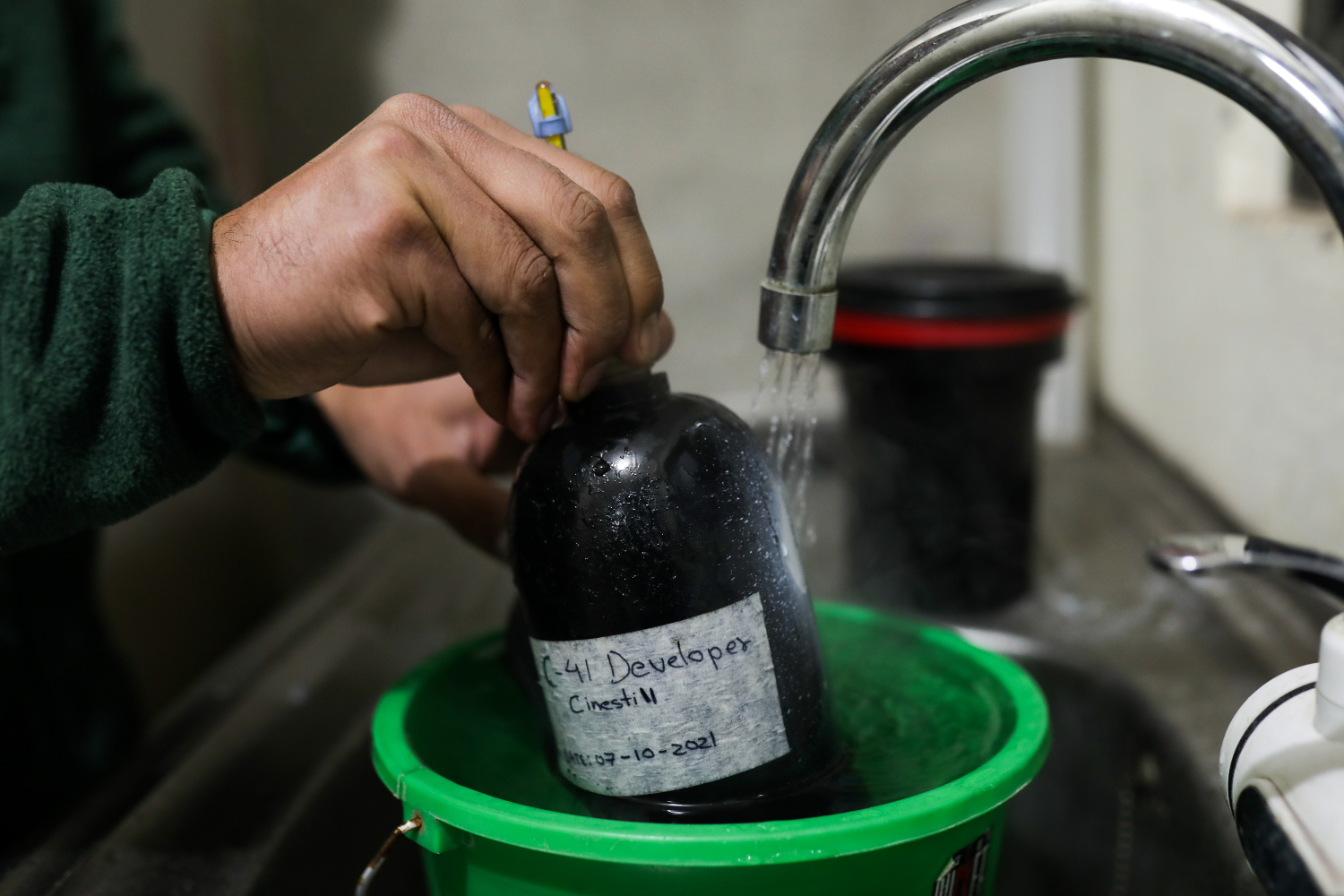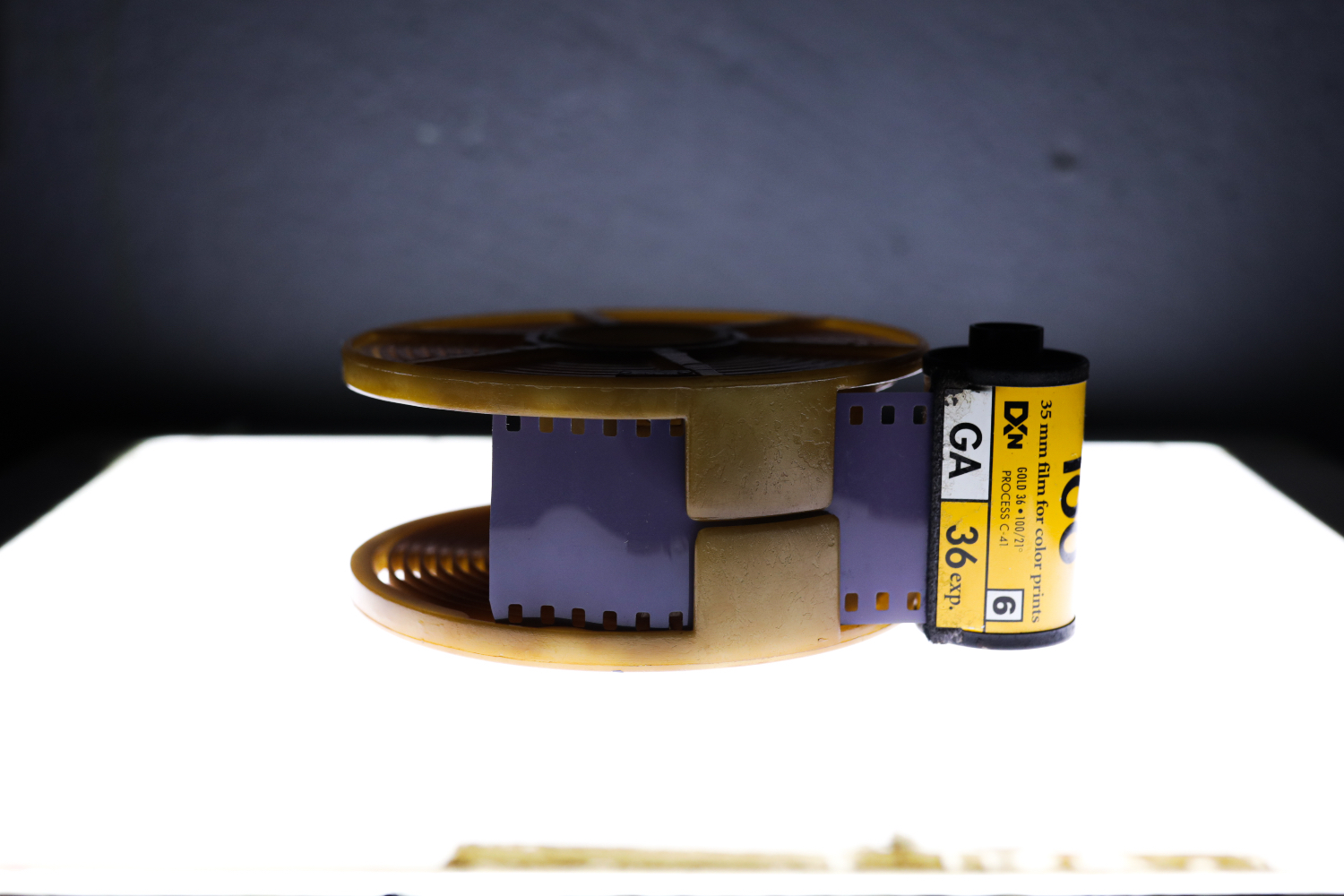Reliving analogue photography
In the darkrooms of Kathmandu, photographers are reviving the lost art of film developingUnder the dim red light of a darkroom, Jagadish Upadhya is getting ready a tray for the stop bath and fixer to print photographs from an exposed negative film reel.
He sets the developed negative on the enlarger, alters the aperture ring and checks the sharpness before masking the frame. He then carefully places the exposed paper in a shallow tray of developer and gently rocks the solution back and forth so the chemicals slowly bring out the image in black and white.
Once it appears, Upadhya puts the paper in the stop bath before removing and draining it. He moves the print into a tray of fixer, gently rocking it again, and inspects the print under a white light and washes it thoroughly before hanging it up to dry.
All this may look archaic to young Nepalis used to snapping away with their mobile phones, applying filters and posting images on Instagram. But before photos went digital, there were film reels, darkrooms and prints — technology that had not changed since photography was first invented 150 years ago. But analogue photography is staging something of a comeback worldwide, and there are afficionados in Nepal also trying to keep the technique alive.
“The entire process of working in the darkroom and playing with chemicals is like cooking,” says Upadhya, who founded Film Foundry, a collective learning and sharing their knowledge of film photography. “I still get fascinated every time I go into the darkroom, I feel like I am in a different realm.”




The phone killed the point-and-shoot camera years ago. Even before that, digital cameras were pushing analogue cameras into obsolescence. But as the world of photography becomes more digital-focused, photographers like Upadhya look to conserve its purist form.
“Film will never die,” says Upadhya. “It is like reading a book. A tablet may be easier to carry around, but you cannot compare the joy of touching the printed pages. Similarly, there is a different sense of satisfaction in physically holding and seeing photographic prints.”
Unlike digital cameras where one can snap away without worrying much about cost, film requires a much more deliberate approach. Each frame costs money to develop and print, and this forces the photographer to be mindful about clicking the shutter button.
The nostalgia associated with the film camera and film rolls is what seems to have pushed the growing trend among photographers to time-travel back to the age of analogue.
In the mid-2010s, when Rupesh Singh’s family was packing up to move house, he stumbled upon an album filled with black and white photos of his father’s childhood. Being a digital native, he had only seen photographs on phones or computers before, but holding family memories in his hands was a defining moment for Singh, who now teaches photography at Kathmandu University.
Read also: Making Nepal’s history colourful, Kanak Mani Dixit



“The medium is unique. It requires a lot of patience and attention. If you make one mistake when developing it, the print turns out blank. But the anticipation of seeing the end-product is what makes it worthwhile,” Singh explains.
When Abishek Shah started his photographic journey, film was the only medium. Photo studios in Kathmandu Valley then were as common as mobile phone shops are today. Over time as things went digital, it became harder to buy film and chemicals. But his love for analogue never faded.
“Unlike digital, film has its own restrictions, but that teaches us to do even more, go even further, learning every day. The importance of film can be conveyed in just one word: patience,” says Shah.
The joy of developing prints is when he processes photos he took months ago in the darkroom. It is not instantaneous like in mobile or digital photography where you can check the screen immediately after taking a shot.
The curiosity about how film cameras work, how an image is formed and how a blank sheet coated in a photosensitive chemical emulsion captures an image of an instant already passed is also what attracted Sanjog Manandhar to film photography.




He had an old point-and-shoot camera at home but there was nowhere to buy film rolls since studios had all gone digital. He got some film reels from his brother in Japan and started clicking.
“Seeing the mistakes I made after the negatives were developed has made me a better photographer,” says Manandhar, a photojournalist with The Kathmandu Post.
In 2019, he founded the Analog Club with Niva Rajbanshi to create a community and a space for photographers to experience the whole process of film photography. One by one they collected films, chemicals, tanks, enlarger, and set up a darkroom. Under the mentorship of Jagadish Upadhya, they taught themselves by trial and error.
“Film photography slows me down in the rush of the digital world where we take hundreds of pictures every day. Yet, we lack learning. What is the point of being happy with just one good photo from hundreds you have taken?” says Niva Rajbanshi. “Film photography slowed me down and gave me time to really understand image processing. It made me pause and think about what I am shooting. And ask: why am I shooting this?”
For commercial photographer Bibash Maharjan Suwal, the joy of shooting in analogue is not only in taking pictures and developing them, but also archiving.
Read also: The way we were, Kunda Dixit

“I take a lot of photos every day, but I have a fear that one day my hard drive gets corrupted. Films, if stored properly, will last in a physical form for a long time,” says Suwal, who started film photography when in school in India.
With film staging a comeback, French photographer Alexandre J Henry came recently to exchange notes with Nepal’s analogue community. Henry says he fell in love with the grain and texture of the analogue prints and started shooting in the format five years ago.
“You can have some deeper layers of black and the contrasts are just amazing in film prints, it is unique compared to digital prints,” he says.
The renaissance of print has also allowed the photographers to experiment with the medium. At Film Foundry, photographers are testing prints in different mediums including wood, canvas and Nepali paper.
Says Abishek Shah: “Back in the days, photos were more for household documentation. People took family portraits, studio portraits, and photos of outings and gatherings as mementos, but now we can be more creative and try something new every day.”
_________________
Negative to positive

The magic of analogue photography takes place on a strip of plastic coated with a light sensitive emulsion of silver halide, with which the exposed parts react. When processed, the lit bits blacken the silver on the film.
- After all 24 or 36 exposures are done, the film is rolled back inside the camera with a small pull-out spool. The camera should not be opened until the negative is inside the roll which is then taken to the darkroom to process.
- Darkroom equipment includes a dark bag, scissors, a daylight developing tank, film reel and chemicals.
- The negative from the exposed roll is loaded on to the film spool inside the dark bag, and the daylight developing tank which is designed in such a way that light does not contaminate the film while the chemicals are being poured in. The lid on the developing tank is there only to cover the tank in case we require agitation in the developing process.
- The choice of chemicals depends on whether the film is black-and-white or colour, which brand it is, the speed of the film, or the preference of the photographer. The temperature of the chemicals also has to be taken into account as it can lead to a difference in the developing time and ultimately the final product. Many senior photographers in Kathmandu swear by the D-76 formula by Kodak as the go-to formula for the most.




- The film, after remaining in the developer for the specified amount of time, will have thrown away excess emulsion and developed images on it. Diluted developers are usually disposed of after the use, and stock chemicals are retained and replenished for future use.
- But the film is not yet ready to be out in the light. It needs to be cleansed with fresh water, which should be the same temperature as the developer with the final couple of minutes in the fixer. This will fully desensitise the remaining silver and make the images permanent allowing us to view it in bright light.
- The image on the film is inverted which is why the film is called a negative. A positive is then obtained by either enlarging the image onto a photographic paper or by scanning and inverting it digitally.
- The dark room has red light, and some photographers first make a contact print of the negative to see which ones should be enlarged.
- The exposed photographic paper is first immersed in a developer, and halted with a stop bath. The paper is then immersed in a fixer solution after which it is washed and hung up to dry.
Read also: Portrait of a photographer in rural Nepal, Monika Deupala




